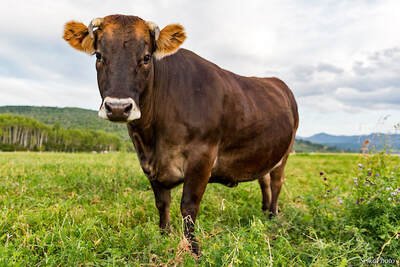Part 2: Nurturing the Farm Organism
Conventional agriculture teaches us to judge a system by the sum of its parts, ignoring synergies and interdependencies inherent in natural systems. By contrast, Rudolf Steiner encourages farmers to look at the farm as an individuality, a whole organism with all of its organs (soil, plant, animal and human) present. Like those of the human body, these organs each contribute their uniqueness to the sustenance and health of each other as well as the greater individual. This point was firmly stressed by Steiner in his second lecture on agriculture in 1924:
"A farm is true to its essential nature, in the best sense of the word, if it is conceived as a kind of individual entity in itself - a self-contained individuality. Every farm should approximate to this condition... ...This ideal cannot be absolutely attained, but it should be observed as far as possible. Whatever you need for agricultural production, you should try to possess it within the farm itself. A thoroughly healthy farm should be able to produce within itself all that it needs."
Steiner also spoke about achieving a balance or homeostasis within the farm. He says, "If a plant especially rich in these cosmic influences is eaten by an animal, the manure that the animal's digestive system provides as a result of consuming such fodder, will be just the right thing for the soil where that plant grows." In other words, the energy in the materials comes full circle from soil to plant to animal to soil. Each time this cycle is repeated, the land becomes healthier and more balanced. The plants on a specific piece of ground do best when their fertility is generated by means of animals grazing on that same ground. Conversely, when inputs come from outside the farm, the farm's potential, quality and overall health become limited.
Viewing farms as self-contained is reflected in modern 'sustainable' agriculture in general as a way to heal the environment. Using inputs primarily from the farm drastically reduces the amount of fuel spent transporting compost and animal feeds. Relying on animals to cycle nutrients saves time and energy when compared to plowing, fertilizing, and cultivating ground. By keeping materials and energy local, the farm becomes more vibrant and our ecologies more healthy.
You don't have to be a farmer to be physically and spiritually connected to a farm. The simple fact that we all eat is what ties us all directly to agriculture. What we choose to eat, in addition to the everyday decisions of the farmer, are what Steiner refers to when he talks about the "human organ." These choices are powerful, going beyond the farm into the local and even global community. By eating local foods, we contribute not only to organic, sustainable farming, but also to local economic sustainability, a resilient community, and even meaningful personal relationships. We believe that people who understand how their food is grown helps to keep the source viable, vital and personal. In these ways, we nourish a symbiosis between the farm and the greater community.
Teton Full Circle Farm is a unique individuality. It is fostered as a whole farm organism as best as possible as we seek to carry out a vision of a hardy, self-contained entity. So far we generate our own compost from on-farm livestock and crop residue which is returned directly to the same land. We feed our cows and chickens from the farm whenever possible with access to fresh pasture, hay, and vegetable scraps and crop residues (for the chickens). In the future, we hope to produce all of our own feed, fertility, and energy to be as self-reliant as possible. At the same time, the farm is inexorably linked to the greater community and its health depends on the choices we all make going forward.
“A vibrant farm is only possible when the needs of the farmer are met, new farmers are nurtured, and those being fed from the farm are integrated into the process. The human organ of the farm is not just the farmer, it's everyone who eats food from this farm.” - Marie Gewirtz
